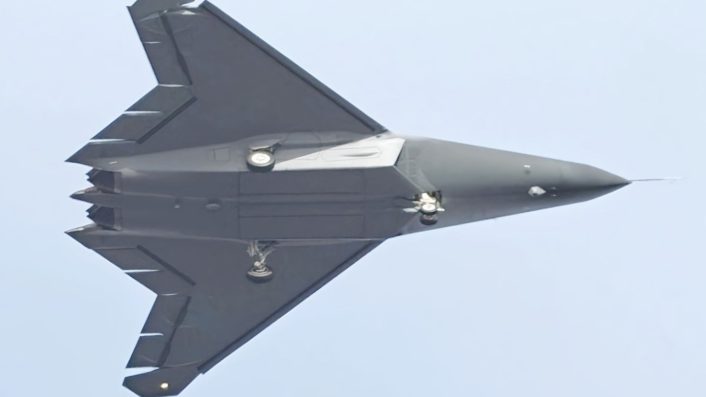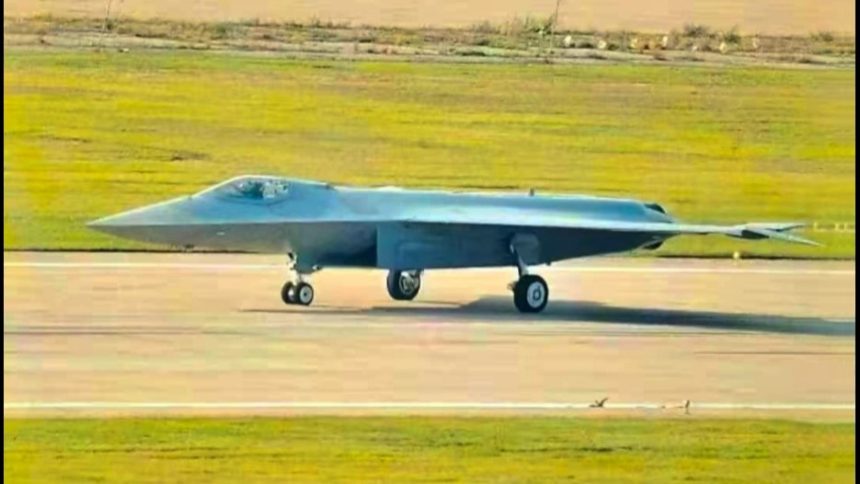For the first time, the J-XDS was photographed at close distance on the ground, revealing new details.
Two new photos, captured off the camera’s screen, show for the first time the Chinese J-XDS stealth jet during taxi on the ground, in what might be our best look yet at the aircraft. Chinese military aviation researchers agree that the image appears to be real and not a computer-generated image (CGI).
Furthermore, Chinese military aviation researcher Andreas Rupprecht mentioned rumors that the photographer was caught climbing the fences at Shenyang Aircraft Corporation’s (SAC) airfield to take the photos. It is unclear, however, if this is the same airframe which has been spotted in recent months or a second one, as it is missing the air data probe which was installed on the nose.
Wow 😯 … I know we have to be careful, especially since the latest CG and PS photos are getting more and more realistic, but according to some rumours the alleged photographer climbed the wall at SAC and was caught. pic.twitter.com/NRW8E5V2uO
— @Rupprecht_A (@RupprechtDeino) September 25, 2025
The new images, both from the front and rear sectors, confirm some earlier observation. Starting from the confirmations of the earliest observations, the aircraft is indeed tailless and manned, with the cockpit apparently hosting a single pilot.
The new images clearly show the J-XDS not only equipped with two engines, but also with 2D thrust vectoring, as was observed in May in the clearest photo of the underside. Additionally, below the nose, an Electro-Optical Targeting System can clearly be seen.
SAC J-50 flying again
Pitot is gone, another unit ? https://t.co/pPGZAsNpA1 pic.twitter.com/nD3XHhjEE0
— Húrin (@Hurin92) September 25, 2025
The J-XDS
The first images of the J-XDS (although it’s worth noting that such designations are speculative) surfaced in late 2024, when photos of a mysterious new tailless stealth fighter began circulating on Chinese social media. At that time, observers noted its unusual lambda-wing planform and lack of vertical stabilizers, sparking speculation that Shenyang Aircraft Corporation (SAC) was testing a new sixth-generation prototype, following the sightings of the Chengdu Aircraft Corporation’s (CAC) J-36.
The new stealth fighter features a tailless design with a lambda wing, which is renowned for its aerodynamic efficiency and reduced radar cross-section. It also boasts a twin-engine setup, Diverterless Supersonic Inlets (DSI), and 2D thrust vectoring nozzles, further enhancing its maneuverability and stealth characteristics.
Someone is indeed going to jail pic.twitter.com/GMgMLHD2pi
— SomePLAOSINT (@someplaosint) September 25, 2025
The lambda wing increases the aspect ratio and boosts aerodynamic efficiency compared to a trapezoidal wing, such as the one seen on the Shenyang J-35, while still meeting the stealth requirements. The wing has a two-segment trailing edge, with a straight center section that sharply angles outward before extending to the wingtips, which however does reduce structural efficiency and adds weight.
Wingtips appear to be movable, pivoting around a central point. The swiveling outer wingtip sections act as major control surfaces, providing significant roll authority and, when deployed together, ability to control pitch.
This design, combined with an advanced digital flight control system, may help address stability issues associated with a tailless configuration. However, this setup also likely reduces low observability due to the jointed areas.
The jet has a tricycle landing gear configuration, with twin wheels on the nose gear, as well as possibly both ventral and side weapon bays. The role of this aircraft is unknown at this time but, based on the size and configuration, it is assumed to be focused mainly on air-to-air.

Continued Sightings
The growing number of sightings and leaked imagery of China’s next-generation platforms, such as the J-XDS and J-36 stealth fighters, may reflect a broader strategic shift. Beijing appears to be deliberately allowing greater visibility into its advanced military programs, a move that aligns with escalating tensions between China and the United States.
The U.S. has its own tailless NGAD demonstrators airborne, as confirmed by the U.S. President and the service leadership, however they have not yet photographed. On the other hand, China has now at least three flying test articles/demonstrators which were sighted in less than a year.
The growing frequency of images and videos showcasing these new aircraft suggests that Beijing may be intentionally making its military advancements more visible. It is, in fact, important to note that many of these flights happen in plain sight over densely populated areas, with higher chances of being caught by people on the ground.
The U.S. has an opposite approach on the matter, flying full-scale flight demonstrators in secrecy for years. The continued sightings of the Chinese demonstrators does not appear to put the United States “in panic mode,” and both nations will still rely on their large fleet of 4th, 4.5 and 5th generation aircraft for the years to come until the new aircraft are possibly fielded.









